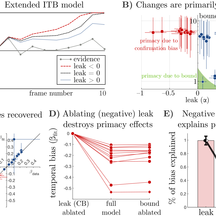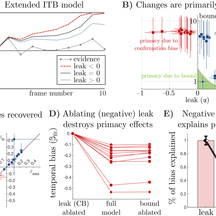
Ralf Haefner
@haefnerlab
Followers
316
Following
442
Media
5
Statuses
155
1/n Our work on a perceptual confirmation bias is finally out. Why do different perceptual decision-making studies find different temporal biases? What is their computational basis? Joint work with @wrongu, @ankani, @jake and Jeff Beck.
journals.plos.org
Author summary When humans and animals accumulate evidence over time, they are often biased. Identifying the mechanisms underlying these biases can lead to new insights into principles of neural...
2
13
39
RT @FUTURUMCareers: In our latest collection of #free #education #resources, we explore #cognitive #science with Professor Ralf Haefner fro….
0
3
0
Blazing-fast image creation – using just your voice. Try Grok Imagine.
320
644
4K
RT @pebenjamters: “How does the primate brain combine generative and discriminative computations in vision?”. The preprint of our @CogCompN….
0
54
0
RT @GrowingUpInSci: Next week (Nov 16), @SussilloDavid will tell his unofficial story. Among all that we have heard over the years, his is….
0
31
0
RT @neuromatch: We believe. 💎 Everyone should be able to read and publish research for free. 🌍 Research publishing should be commonly owned….
0
236
0
RT @TonyZador: Faculty search in COMPUTATIONAL/THEORETICAL NEURO at CSHL. Please spread the word!.
0
20
0
@sabyashiv1729 @DMWolpert @lengyel_m (Co-)first author refs only:.Approx causal inference w/ @maddox_lab.Differences in causal inference between ASD observers & controls w/ @JP__NOEL &Dora Angelaki.Active sensing w/ @AnkaniChattoraj. more soon.
elifesciences.org
Individuals within the autism spectrum disorder implicitly outweigh integration (rather than segregating) when performing causal inference and have developed an explicit compensatory mechanism as...
0
0
1
Congratulations to @sabyashiv1729 for defending his PhD! 🥂🍾.Excellent and wide-ranging work on approximate inference in motion processing, cue integration and active sensing. and soon becoming a postdoc w/@DMWolpert & @lengyel_m
4
0
27
RT @sabyashiv1729: Great experience collaborating with @JP__NOEL, @AngelakiLab and @haefnerlab! .Modeling takeaways in thread.
0
2
0
RT @CogCompNeuro: There are only TEN DAYS left to submit your proposal for a GAC at CCN 2022!. “A GAC?“, you say. “What’s a GAC?”. Allow us….
0
14
0
Check out our #VSS2022 poster on the limits and time scales of perceptual confirmation bias during visual evidence integration on Sun AM with @xuan_wen_99 @AnkaniChattoraj. Based on with @wrongu @jcbyts and Jeff Beck.
journals.plos.org
Author summary When humans and animals accumulate evidence over time, they are often biased. Identifying the mechanisms underlying these biases can lead to new insights into principles of neural...
0
1
6
Interested in how and why perceptual confirmation bias leads to overconfidence during evidence integration? Check out @AnkaniChattoraj’s poster on Sun AM #VSS2022 Continuation of with @MSnarskis.
0
1
9
RT @fhuszar: Postdoc on Probabilistic Machine Learning with @ZoubinGhahrama1 and me in Cambridge. If you know anyone interested, please enc….
0
40
0
RT @nencki: We are happy to announce Nencki School of Ideas in Neuroscience! We are going to discuss exciting theories, have a philosopher'….
0
85
0
@wrongu @ankani @jake 8/n Many thanks to @summerfield, @realrickborn, @nienborglab, @aplabur, @azylb, Duje Tadin and many others for helpful comments.
1
0
1
@wrongu @ankani @jake 3/n Example: Left: low sensory information (hard to detect orientation on each frame) and high category information (all frames have the same orientation). Right: high sensory (orientation clear on each frame) and low category information (orientations flip back and forth)
1
0
1








